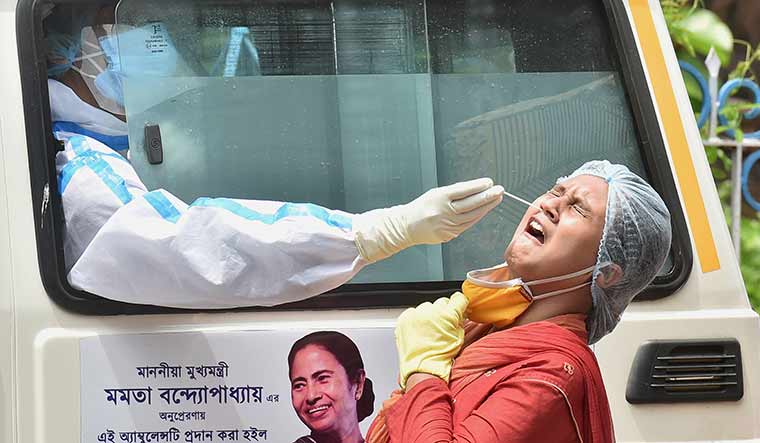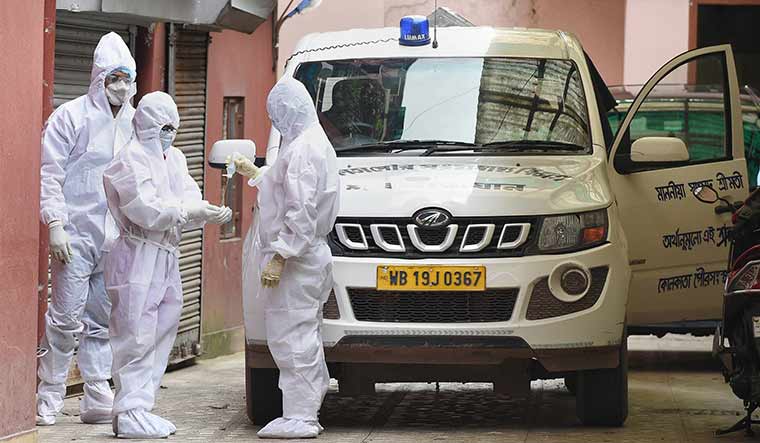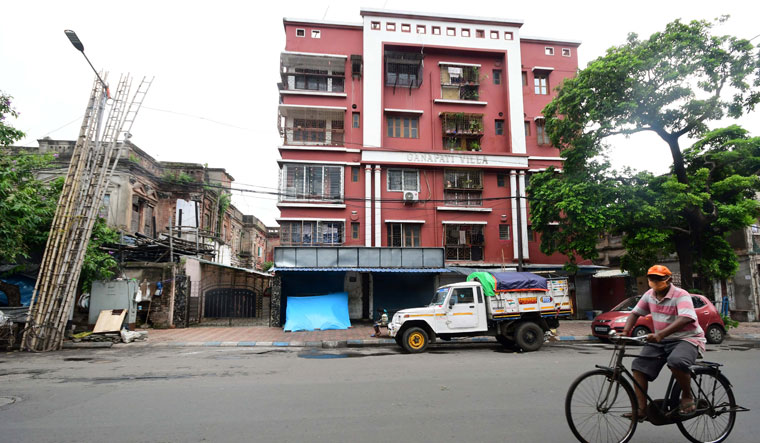SWAPAN GHOSH chose to run a small sweet shop in Kolkata, although he was from Singur in Hooghly district, one of the most fertile regions in West Bengal. The 55-year-old, however, had to shut his shop and return to his village following the nationwide lockdown imposed on March 26 to tackle the Covid-19 pandemic. He was back in business a few weeks later, after Chief Minister Mamata Banerjee permitted the reopening of shops, especially in Kolkata.
When the unlock process began, Kolkata residents perhaps let down their guard. From pakora joints to paani puri stalls, all shops were crowded. Ghosh’s shop, too, was packed. A few days after reopening his shop, he started having intermittent fever, cough and cold. On June 30, a local doctor asked him to get tested for Covid-19. Ghosh got himself tested at a Covid-19 hospital on July 2 and died the next day, before the results came. As the hospital did not issue a death certificate, his body could not be cremated. As the morgues were full, it was kept in his shop. Corporation officials took the decomposed body away for cremation after his test results came back positive. Ghosh’s worried customers are now trying to get themselves tested.
Back in Singur, Ghosh’s family has no clue about how he contracted the infection. His wife and two children are inconsolable. “We will help the family financially if required. They are already getting free ration,” said Mahadeb Das, block president of the Trinamool Congress. He said infections were going up in Singur. “All are caused by migrant workers. We are finding it hard to stop the disease from spreading,” he said.
Seventy-year-old Prashanta Bose (name changed on request) from Amherst Street in Central Kolkata, too, fell ill around the same time. His family consulted a local doctor, who came wearing personal protective equipment. “He gave some medicines and ordered a Covid-19 test,” said Bose’s nephew. The family contacted Calcutta Medical College, the nearest testing facility. Bose took the test on June 29 and, like Ghosh, died the next day, while waiting for the results. The family could not find a morgue; they kept the body in a hired ice cream freezer. “We paid 020,000 for it,” said a family member.
His family blames the system which, it feels, has made the detection of Covid-19 a complex issue. “Although he had a cough and shortness of breath, he never thought of getting tested as no one thought he could contract the infection. Even the local doctor who treated him was not sure that he had Covid-19. But we got worried as he came wearing PPE,” said Bose’s nephew.
Corporation authorities came to take the body away for cremation on July 2, after the test results returned positive. Atin Ghosh, deputy mayor of the Kolkata municipal corporation, said the corporation did not want to put its staff at risk. “There are rules for handling such bodies. The blood report was more urgent,” he said. Now the entire Bose family is being tested and have been placed under quarantine for 14 days. Also, tests are being intensified in the area near the Bose residence.
Despite the precautions adopted by the corporation and health officials, people are dying at homes and families are finding it tough to get death certificates and a slot in the morgue. On July 4, a 72-year-old resident of Sodepur in North 24 Parganas district was admitted to a hospital in Barrackpore. As her condition deteriorated, she was sent to Kolkata. But when the patient reached the city hospital, she was sent back. Her son, Biswajit De, made an emotional appeal to the health department to save his mother; she was admitted to a private hospital after the department intervened.
“It is pathetic and careless. We are facing a grave situation,” said Dr Amitava Nandy, former adviser to the Indian Council of Medical Research and former consultant to the World Health Organisation.
Nandy said the ICMR was following guidelines prescribed by WHO-approved international journals like gospel truth, without assessing their impact across different geographic locations. “The ICMR was under tremendous pressure from Central and state governments to act. But science cannot function like that,” said Nandy. Calling the home quarantine destructive, he said such methods accentuated the spread of the virus in India. “The ICMR failed to understand that what is good in Europe may not be good for India, where common people are not that much literate,” he said. “Also, it brought technology and kits without standardising them to suit India’s geographical situation. So we had bad kits and bad methods of testing and then bad methods of safety. Everything went against us.”
Nandy said the Central and state governments tried to reap political benefit out of the situation, and some businessmen made huge profits. “While the governments wanted to downplay the epidemic by not circulating enough information, many companies started producing fake safety kits and masks,” he said. He said the rushed declaration of a vaccine was yet another example of the ICMR allowing itself to be put under pressure.
According to Nandy, because of the inadequate preventive measures, patients are dying and hospitals are running out of beds, forcing people to get treated at home. “How can such infectious patients be treated at home? They are bound to infect others, including children and the elderly who have comorbidities,” he said.
Nandy said the way Ghosh and others died showed that people were being forced to conceal the disease. “They are afraid of being stigmatised,” he said. “Even doctors cannot enter their apartments after coming back from duty. Covid-19 has become a social curse in Bengal and perhaps in many other states.”
Covid-19 numbers in West Bengal have been rising steadily, although the number of tests remained low at 5,000 tests per million people. The return of migrant workers has added to the crisis. Random rapid antibody tests done in and around Kolkata have shown an infection rate of 14 per cent. The conclusion is that asymptomatic patients must have infected the people at home during the lockdown, including the elderly and the vulnerable. Experts said the government failed to announce basic information like the lists of Covid-19 hospitals and the number of beds available in each place at any given time. WHO-empanelled molecular virologist Partho Sarathi Roy said only 5 per cent of Covid-19 patients would require critical care in hospitals. “It is disheartening that the government is finding it hard to give such a small number of people proper hospital facilities,” he said.
Nandy said the government had missed the bus. “Yes, only five per cent would require hospital care,” he said. “Today, the rate of infection is around 15 per cent. But when it reaches 70 per cent, that 5 per cent will be a big number. The Central and state governments fear that such a situation will hit them politically if they fail to provide treatment to such a big number.”
That fear was perhaps the reason why Prime Minister Narendra Modi extended the free ration scheme till November. The Centre has also offered other freebies such as direct money transfer worth 01,000 crore and free cooking gas cylinders for people below poverty line. After Modi’s announcement, Mamata said she would extend the free ration scheme till June 2021. But the West Bengal government is already finding it difficult to fund its ambitious schemes. Finance Minister Amit Mitra said the Modi government had not given West Bengal even “a single rupee” to tackle Covid-19. “What they are saying is untrue. We have had to arrange our own money to fight the pandemic,” said Mitra.
Government sources, however, indicated that money would not be a problem for Mamata’s grand schemes, especially with assembly elections due in 2021. “We have no shortage of food, as we buy rice directly from farmers,” said Food Minister Jyotipriyo Mullick. “We will feed the people of Bengal freely.”





